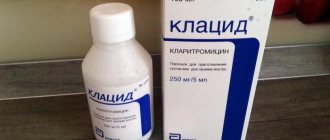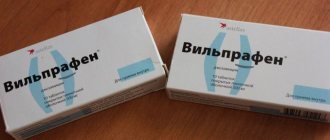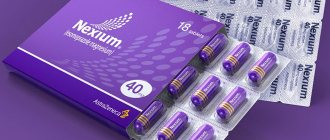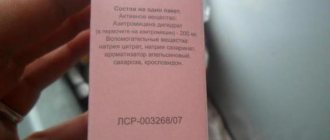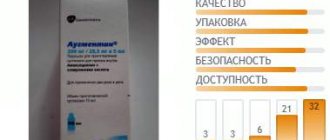pharmachologic effect
This is a modern antibiotic produced for the treatment of inflammatory diseases in adults and children in the form of tablets and granules for the preparation of a suspension. Sold in pharmacies with a prescription, like its analogues.
The active substance is cefixime from the group of cephalosporins. Has the following therapeutic effects:
- prevents the activity of bacteria, causative agents of infectious and inflammatory diseases at the cellular level;
- has an antibacterial effect;
- is not exposed to special bacterial enzymes (B-lactamases), which destroy many antibiotics.
Release form and composition
Dosage forms of Pancef:
- Film-coated tablets: pale cream, biconvex, oblong, with a score on one side (5 or 6 pieces in a perforated blister, made of PVC/TE/PVDC film and aluminum foil; 1 blister of 6 pieces or 2 blisters of 5 pieces in a cardboard box);
- Granules for oral suspension: pale yellow to yellow; prepared suspension: homogeneous, white or pale yellow liquid with the smell of orange (60 ml of suspension - 32 g of granulate each in a dark glass bottle with a screw-on aluminum cap, with a PE gasket and tamper evident, in a cardboard box 1 bottle with measuring cap; 100 ml of suspension - 53 g of granulate in a dark glass bottle with a screw-on aluminum cap, with a PE gasket and tamper evident, in a cardboard box 1 bottle with a measuring cap).
The active substance is cefixime (in the form of cefixime trihydrate), the content depends on the form of release:
- Film-coated tablets: 0.4 g/piece;
- Granules for preparing a suspension for oral administration: 60 ml of suspension – 1.207 g (0.1 g/5 ml); 100 ml of suspension – 2 g (0.1 g/5 ml).
Additional components:
- Tablets: microcrystalline cellulose, titanium dioxide (E171), macrogol 4000, hypromellose, magnesium stearate, sodium lauryl sulfate, corn starch, gelatin, calcium dihydrogen phosphate, pregelatinized starch;
- Granules: orange flavor, sodium benzoate, xanthan gum, sucrose.
Indications for use of Pancef
Suspension for children and tablets are used in the following cases:
- infectious and inflammatory diseases of the nasopharynx (pharyngitis, sinusitis, tonsillitis);
- acute or chronic form of bronchitis;
- kidney and urinary tract diseases, gonorrhea, occurring without complications;
- otitis media of the middle ear.
For greater effectiveness, before prescribing the drug, the sensitivity of the microorganisms that caused the disease to certain antibiotics is determined.
Contraindications
The instructions for use of the Pancef suspension for children contain information about some restrictions for its use. The drug is not indicated for a number of patients:
- expectant and nursing mothers;
- newborns under six months old;
- people who have an individual intolerance to any component in the structure of the medicine.
With great caution, the drug can be recommended to people of mature age and those who suffer from renal failure. Treatment of such patients should be under the supervision of a physician.
Pancef - instructions for use
The antibiotic is easy to use: once a day or divided into two doses for 7-10 days. The dosage and course of treatment depend on the age, weight of the patient, the disease and its severity, and concomitant diagnoses in the anamnesis. Since the drug is 50% excreted by the kidneys, in case of renal failure, dosage adjustment is necessary to reduce the load on the organ.
Pancef is used with caution in the elderly, in children from 6 months of age only as prescribed by a doctor.
Important! Do not exceed the dosage and duration of use recommended by your doctor. If the instructions are not followed, there is a risk of severe diarrhea and disruption of the normal intestinal microflora (dysbacteriosis).
How to take: before or after meals
When taking Pancef, undesirable reactions from the gastrointestinal tract (diarrhea, vomiting, nausea, pain, and others) are possible. To minimize them, it is recommended that children and adults drink after meals to prevent irritation of the gastric mucosa.
Directions for use and doses
For adults and children over 12 years of age weighing more than 50 kg, the daily dose is 400 mg (1 time/day or 200 mg 2 times/day). The duration of treatment is 7-10 days. For uncomplicated gonorrhea - 400 mg once.
Children under 12 years of age - 8 mg/kg body weight 1 time/day or 4 mg/kg every 12 hours. For infections caused by Streptococcus pyogenes, the course of treatment should be at least 10 days. For impaired renal function (with CC from 21 to 60 ml/min) or in patients on hemodialysis, the daily dose should be reduced by 25%. For CC ≤20 ml/min or in patients on peritoneal dialysis, the daily dose should be reduced by 2 times. Children in aged from 6 months to 12 years with a body weight of less than 50 kg, the drug is prescribed as a suspension at a dose of 8 mg/kg body weight 1 time/day or 4 mg/kg every 12 hours:
| Body weight (kg) | Dose/day (measuring cap, ml) | Dose/day (mg) |
| up to 6.0 | 2.5 | 50 |
| 6,0 — 12,5 | 5 | 100 |
| 12,5-25,0 | 10 | 200 |
| 25,0-37,5 | 15 | 300 |
| 37,5- 50 | 15-20 | 300-400 |
The average duration of treatment is 7-10 days. For infections caused by Streptococcus pyogenes, the course of treatment should be at least 10 days. Due to differences in bioavailability, it is not recommended to replace the suspension with tablets. In case of impaired renal function, the dose is set depending on the creatinine clearance in the blood serum: with a creatinine clearance of 21-60 ml/min or in patients on hemodialysis, the daily dose should be reduced by 25%; with a creatinine clearance of 20 ml/min or less or in patients on peritoneal dialysis, the daily dose should be reduced by 2 times.
Method of preparation of 60 ml of suspension for oral administration 100 mg/5 ml. The suspension is prepared immediately before the first use. Shake the bottle several times. Using a measuring cap, add 40 ml of boiled water cooled to room temperature in 2 stages and shake vigorously after each addition until a homogeneous suspension is formed. To dose the finished suspension, use a measuring cap, which should be rinsed well with water after each use. Shake the bottle well before use.
Pancef's analogues
The choice of what can replace Pancef depends on the indications, restrictions on use, severity of the disease and pathogen, age (child, adult or elderly). It should be done together with a specialist due to possible adverse reactions and insensitivity of the selected antibiotic to microorganisms, which will subsequently lead to complications.
Analogues of the drug:
- Suprax;
- Ixim Lupine;
- Cemidexor;
- Azithromycin (Sumamed);
- Amoxicillin;
- Amoxiclav (Flemoklav solutab, Augmentin);
- Clarithromycin (Klacid);
- Vilprafen;
- Ceftriaxone;
- Cefotaxime;
- Cefazolin and others.
Suprax, Ixip Lupine and Tsemidexor are analogues of Pancef 400 in terms of the main component. Their action is based on cefixime, the release forms, manufacturer, and price differ.
Cefuroxime or Zinnat is an antibiotic of the same group and spectrum of action as Pancef, an older generation. Apply twice a day. Available in tablets and granules for preparing a liquid form for children.
Ceftriaxone, Cefotaxime and Cefazolin are older generation injectable antibacterial drugs used in difficult cases 2-3 times a day.
Vilprafen also has a wide spectrum of antibacterial action, is often prescribed for STDs, gonorrhea, and is the drug of choice for pregnant women.
| Analogue | Price | Manufacturer country |
| Suprax | 550-900 | Italy |
| Sumamed | 200-600 | Croatia |
| Azithromycin | 50-90 | Russia |
| Amoxiclav | 100-450 | Austria |
| Amoxicillin | 35-95 | Russia |
| Cefotaxime and other injections | 20-30 per bottle | Russia, Belarus |
| Vilprafen | 530-660 | Germany, France |
| Flemoxin solutab | 200-550 | Netherlands |
The mechanism of action of the drug Pancef 400
The drug belongs to the group of antimicrobial agents. The active substance is a cephalosporin of semi-synthetic origin. Has a wide range of effects. Exhibits bactericidal properties.
The drug Pancef 400 exhibits bactericidal properties.
Pharmacodynamics
Cefixime inhibits the synthesis of the cell membrane of a bacterial agent. It shows resistance to the influence of beta-lactamases. Therefore, it is effective against many gram-positive and gram-negative bacteria.
There are microbes that are resistant to the effects of the active substance, in the form of:
- pseudomonas;
- enterococci and streptococci from the serogroup;
- listeria;
- staphylococci;
- enterobacteria;
- bacteroids;
- clostridia.
Resistance in microorganisms develops gradually.
Pharmacokinetics
You can take the medicine regardless of meals. The active component binds to blood proteins by 65%.
The active component of the drug Pancef 400 binds to blood proteins by 65%.
Reaches maximum concentration after 3-4 hours, in some cases - after 9 hours. It is excreted unchanged in urine, bile and feces.
Pancef or Suprax – which is better?
Pancef is an antibiotic produced in Macedonia and is a generic or reproduction of Suprax (Italy) based on cefixime. It is available in tablets for adults and suspensions for children. Price – 400-850 depending on the shape.
Suprax is better suited for children, since clinical trials were conducted on it; there may be differences in excipients, purification, and manufacturer of raw materials.
Disadvantage: the cost is 1.5-2 times higher. Available in capsules, suspensions for children, dispersible or water-soluble or oral tablets for children and people with swallowing difficulties.
The indications and restrictions for prescribing the two medications are the same.
Name
The manufacturer of the drug is the Republic of Macedonia. The pharmacological name of the company is ALKALOID AD.
The pharmacological name of the company that produces the drug is ALKALOID AD.
Latin name
Pancef
International nonproprietary name
Cefixime
Pantsef or Sumamed
Sumamed is a substitute for Pancef based on azithromycin, available in tablets for adults, capsules and suspensions for children. The indications are the same; in addition, it can be used for pneumonia. The dosage and choice of form depends on the patient's age and ability to swallow the tablet or capsule. An analogue of Pancef tablets has a rapid antibacterial effect and fights the pathogen within 3 days of taking the medication. This fact proves that the drug has an aggressive effect on the body and can be used for quick recovery or in difficult situations.
It is better for children to choose Pancef - it effectively acts on the pathogen, less often leads to undesirable consequences like its analogue (headache, diarrhea, nausea, vomiting, changes in blood counts).
If pathogens are resistant to the composition, cheap Russian analogues of Sumamed can be used: Azithromycin, Azitrox, Zitrolide, Z-factor.
special instructions
Individuals with a history of allergic reactions to penicillins may experience increased sensitivity to cephalosporin antibiotics. If an allergic reaction develops, the drug should be stopped and adequate measures taken.
During long-term treatment with Pancef, intestinal microflora may be disrupted, which can provoke the growth of Clostridium difficile, manifested by severe diarrhea. When this side effect develops, it is extremely important to consider the threat of the possible appearance of pseudomembranous colitis.
During therapy, a false-positive urine reaction to glucose, ketonuria, as well as a false-positive direct antiglobulin test may be observed.
Pancef or Amoxiclav - which is better?
Amoxiclav is a combined antibiotic analogue based on amoxicillin and clavulanic acid. The first component has a strong antibacterial effect, the second protects the antibiotic from B-lactamase enzymes. Produced in Austria, in the form of regular tablets, dispersible (soluble) form and suspension.
The following medications are similar to the drug Amoxiclav in action, release form, and composition: Flemoklav solutab, Augmentin, Panklav, Medoclav, etc.
Preparations Pantsef or its analogue for children and adults Amoxiclav have an antibacterial effect of similar strength and spectrum and are protected from B-lactamases. These are two high-quality imported medicines, you can choose either one.
Analogs
If the drug is not on sale, then you can buy a medicine with a similar composition:
- Suprax.
- Ceforal Solutab.
- Ixim Lupin.
If an allergic reaction develops, penicillins and cephalosporins should be avoided. Then the doctor replaces the medicine with other analogues:
- Azaran.
- Rocephin.
- Dardum.
- Movigip.
- Cephobid.
- Cefoperus.
Before use, you must read the instructions and exclude any contraindications.
Pantsef or Klacid - which is better?
Klacid is an Italian analogue based on clarithromycin in powders and tablets. It is used twice a day, unlike Pancef. Often, when taking it, undesirable reactions occur - diarrhea, rash, abdominal pain, nausea, vomiting, intense sweating, and other side effects.
When choosing between Pancef and Cefixime , it is better to choose the second drug, it is gentler and safer, and more convenient to use (once a day).
When choosing cheap analogues of a medication, you should weigh the expected benefits and risks, read the instructions for common adverse reactions and consult your doctor. In childhood, all replacements are recommended to be made with a pediatrician.
Side effects
- Hematopoietic organs: hemolytic anemia, aplastic anemia, bleeding, thrombocytopenia, agranulocytosis, neutropenia, leukopenia, pancytopenia;
- Digestive system: cholestatic jaundice, cholestasis, dysbacteriosis, pseudomembranous enterocolitis, constipation, abdominal pain, diarrhea, vomiting, stomatitis, nausea;
- Allergic reactions: fever, eosinophilia, itching in the genital area, skin itching, skin hyperemia, urticaria, toxic epidermal necrolysis, exudative erythema multiforme;
- Genitourinary and urinary system: vaginitis, interstitial nephritis;
- Nervous system: headache, tinnitus, dizziness;
- Laboratory indicators: hypercreatininemia, hyperbilirubinemia, increased activity of alkaline phosphatase and liver transaminases, increased urea nitrogen, increased prothrombin time;
- Other: shortness of breath, hypovitaminosis B, candidiasis.
A sign of an overdose of Pancef is the worsening of adverse reactions. For this condition, gastric lavage, symptomatic and supportive therapy are prescribed. Hemodialysis and peritoneal dialysis are ineffective.
Pantsef
Active substance:
Cefixime*
Pharmgroup:
Cephalosporins
Average price in pharmacies
| Name | Manufacturer | average price |
| Pantsef (cefixime) 0.4 n10 tablet p/o | Alkaloid AO | 874.00 |
| Pancef 0.1/5ml 32.0 60ml n1flac gran d/susp | Alkaloid AO | 452.00 |
| Pancef 0.1/5ml 53.0 100ml n1 gran flask d/susp | Alkaloid AO | 619.00 |
| Panzef 0.4 n6 tablet p/capt/shells | Alkaloid AO | 612.00 |
| Panzef 0.4 n7 tablet p/capt/shells | ALKALOID-RUS | 719.00 |
Analogs for the active substance:Ixim Lupine Suprax CEMIDEXOR Ceforal Solutab Cefspan |
Adverse reactions
Taking the antibiotic "Pancef" in children can cause an undesirable response from the body. Treatment can lead to a number of unpleasant symptoms:
- the appearance of nausea, vomiting, headache and dizziness;
- appetite disorder;
- disruption of habitual bowel movements;
- the appearance of abdominal pain;
- increasing levels of liver transaminases;
- an increase in the level of bilirubin in the urine;
- development of jaundice;
- detection in laboratory blood tests of an imbalance of leukocytes, platelets, neutrophils, erythrocytes;
- manifestation of allergic signs (itching, redness, swelling).
As in the case of treatment with antibacterial agents of other series, taking Pancef can disrupt the microflora of the gastrointestinal and genitourinary organs, causing dysbacteriosis or candidiasis.
Cases of development of pathological conditions such as while taking the drug are extremely rarely recorded:
- interstitial nephritis (acute or chronic non-purulent inflammation of the stroma and tubules of the kidneys);
- glossitis (inflammation of tongue tissue);
- enterocolitis (inflammation of the large and small intestines);
- exudative erythema (acute disease of the skin and mucous membranes);
- toxic epidermal necrolysis (severe pathology accompanied by rejection of the surface layer of skin and disturbances in the functioning of internal organs).
Reviews from specialists and parents
The vast majority of doctors' assessments are positive. Its effectiveness in the treatment of infectious pathologies caused by bacteria, ease of use and a minimal set of undesirable manifestations are noted. The mixture has a pleasant taste, aroma, and is convenient for treating the youngest patients.
In addition, its structural components combine well with antihistamine and immunostimulating drugs. At the same time, there is a negative impact of Pancef on kidney function. Therefore, it is recommended with caution to patients with similar problems.
Parents also note its high effectiveness in relieving cold symptoms, including positive reviews of the “Pancef” suspension for children for bronchitis and otitis media. It is noted that already at the beginning of treatment the temperature decreases and the general condition improves. There are many good reviews about Pancef for children with sore throat.
